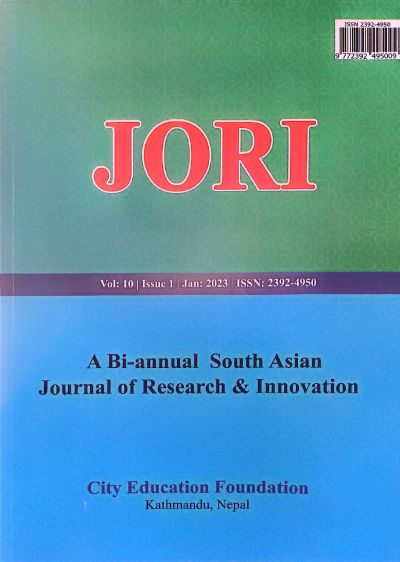Impact Of Climate Change In Agricultural Production: A Case Of Koshi River Basin, Nepal
DOI:
https://doi.org/10.3126/jori.v10i1.66077Keywords:
climate change, agricultural production, Koshi river basin, adaptationsAbstract
The climatic factor has played dominant role on affecting agricultural production in the region. This study focused on analyzing the impact of Climate change in agricultural production in two districts of Nepal. Sunsari district had experienced the highest annual temperature increased (0.0038°C/yr) during 1990 and 2022, whereas the Saptari district had faced sharp decline in rainfall (11.442 mm/yr). Climate change resulted into climate induced disasters such as recurring drought, catastrophic flooding, mass wasting and emergence of pests. The climate data during 1990 and 2022, was used to find climate trend analysis. The inter-annual climatic patterns across time were examined using the trend analysis test and trend line slope. The HH survey concluded with increased in temperature and crop diseases emergence along with increase in the frequency of pests, drought and floods, and decreased in rainfall as perceived by majority of respondents. These parameters were expected to cause negative effect on crop output, human health, animals and vegetation. An increasing tendency in temperature and declining trend in precipitation were the two main climatic trends that were observed in the study area. Climate trends in Barahakshetra of Sunsari district of the KRB showed an increasing rate of precipitation of 7.8021 mm/year. The linear trend analysis of pre-monsoon time showed the precipitation was increasing at the rate of 3.4424 mm/year. The trend of post-monsoon rainfall increased significantly at the rate of 1.7956 mm/year. The Climatic trends as indicated by Barmajhiya Station in the Saptari district of the KRB showed decreasing rate of annual precipitation with 11.442 mm/year. In Saptari district, the annual production of paddy has been observed in decreasing trend of 1092.9 Mt. per year, with the increasing trend of cultivation area with 673.55 ha per year. The decreasing trend of cultivation area was observed with 17.918 ha per year. The HHs survey ascertained that, the majority of respondents perceived the increased temperature and drought with heavy rainfall and flood in the locality. The springs and ponds were at stake resulting into water scarcity with low discharge in rivers.




